#richard lenoir
Explore tagged Tumblr posts
Text

Bonjour, bonne journée ☕️ 🌥
"La Grosse Bouteille" boulevard Richard Lenoir🗼Paris 1953
Photo de Jean Marquis
#photographie#black and white#vintage#photooftheday#jean marquis#paris#richard lenoir#la grosse bouteille#bonjour#bonnejournée#fidjie fidjie
37 notes
·
View notes
Text
Reflecting circles
The reflecting circle was invented by the German geometer and astronomer Tobias Mayer in 1752, with details published in 1767. His development preceded the sextant and was motivated by the need to create a superior surveying instrument.

A Mayer circle, 18th century
It is a complete circular instrument graduated to 720° (to measure distances between heavenly bodies, there is no need to read an angle greater than 180°, since the minimum distance will always be less than 180°). Mayer presented a detailed description of this instrument to the Board of Longitude and John Bird used the information to construct one sixteen inches in diameter for evaluation by the Royal Navy. This instrument was one of those used by Admiral John Campbell during his evaluation of the lunar distance method. It differed in that it was graduated to 360° and was so heavy that it was fitted with a support that attached to a belt. It was not considered better than the Hadley octant and was less convenient to use. As a result, Campbell recommended the construction of the sextant.
Jean-Charles de Borda further developed the reflecting circle. He modified the position of the telescopic sight in such a way that the mirror could be used to receive an image from either side relative to the telescope. This eliminated the need to ascertain that the mirrors were precisely parallel when reading zero. This simplified the use of the instrument. Further refinements were performed with the help of Etienne Lenoir. The two of them refined the instrument to its definitive form in 1777. This instrument was so distinctive it was given the name Borda circle or repeating circle. Borda and Lenoir developed the instrument for geodetic surveying. Since it was not used for the celestial measures, it did not use double reflection and substituted two telescope sights. As such, it was not a reflecting instrument. It was notable as being the equal of the great theodolite created by the renowned instrument maker, Jesse Ramsden.
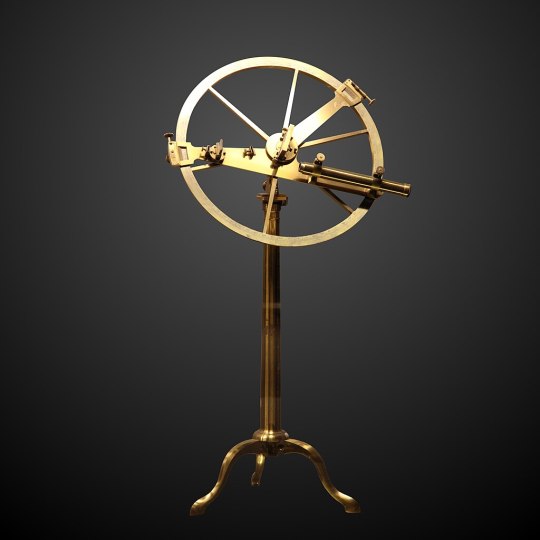
A Jean-Charles de Borda circle, by Étienne Lenoir 1775
Josef de Mendoza y Ríos redesigned Borda's reflecting circle in 1801. The goal was to use it together with his Lunar Tables published by the Royal Society. He made a design with two concentric circles and a vernier scale and recommended averaging three sequential readings to reduce the error. Borda's system was not based on a circle of 360° but 400 grads (Borda spent years calculating his tables with a circle divided in 400°). Mendoza's lunar tables have been used through almost the entire 19th century. Edward Troughton also modified the reflecting circle. He created a design with three index arms and verniers. This permitted three simultaneous readings to average out the error.
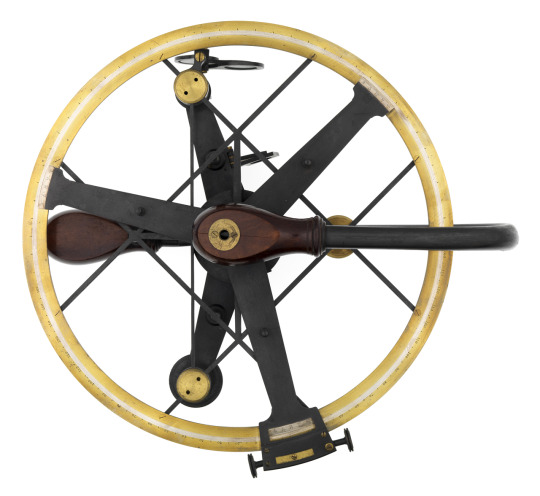
A Troughton Circle, 1803
As a navigation instrument, the reflecting circle was more popular with the French navy than with the British.
M. Daumas, Scientific Instruments of the Seventeenth and Eighteenth Centuries and Their Makers, London 1989
William Edward May, A History of Marine Navigation, G. T. Foulis & Co. Ltd., Oxfordshire, 1973
Richard, Dunn, Navigational Instruments, London 2016
79 notes
·
View notes
Text
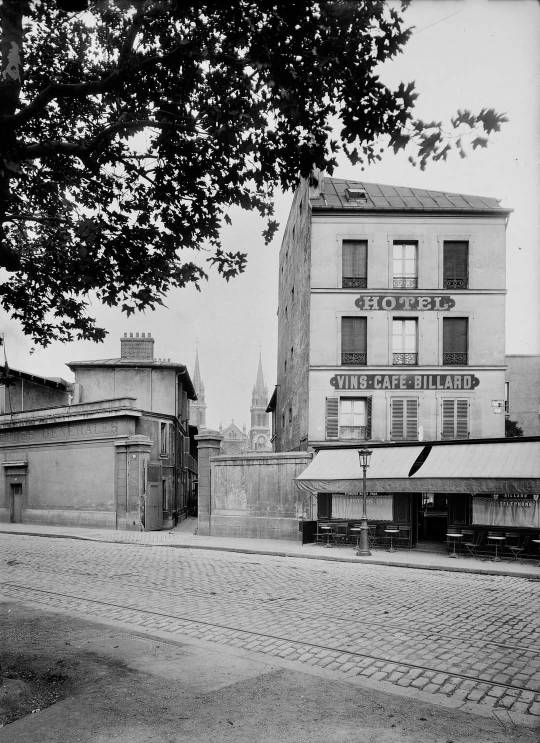
Charles Lansiaux
64-66 boulevard Richard Lenoir
À l'arrière-plan, flèches de l'église Saint-Ambroise.
Paris 1920
34 notes
·
View notes
Text
FFAN Wrap-Up & Recs
Introductory post
Masterpost
This concludes our foray into Famous Five vintage (and not-so-vintage) art!
I started this project about a year and a half ago and I’m very pleased to have brought it to its conclusion. I ultimately got more ambitious that I imagined at the start, and managed to gather physical copies from almost every edition from the 1950s to the 1980s (I also have a few from the 1990s onwards, but I didn’t make a concerted effort to find them all as they rarely contain original inside illustrations, and the cover art can be found online). The only physical book I know I’m missing is one from the Swiss publisher with Umberto Nonna’s illustrations. If it so happens that I find a copy of this book – or any additional editions that I don’t currently know of – I will make an additional post to the FFAN series, but until then I’m calling it done!
You can expect three more posts over the next few days focusing on the Five enjoying fun outdoorsy activities to accompany you into summertime! 🎒🏕️🏖️🌞
And to wrap thing up, I thought I’d share some light about my favourite books from both Blyton’s and Voilier’s series.
From Enid Blyton’s original series:
#10 Five On A Hike Together: I love how the action is condensed over five days, with the events leading smoothly one to the other. The children were just going on a carefree hike, when they inadvertently get pulled into a mystery and solve a puzzling “treasure map”. They get to show their wits, be self-reliant, outsmart the bad guys, and find the treasure just in time before going back to school, all the while enjoying the lovely scenery of the countryside in the fall! Dick and Anne also get their special moment in the spotlight, which doesn't happen in many of the books.
#03 Five Run Away Together: The first adventure where the Five go off on their own for an extended period of time without any adults around. I think this one appealed to me when I was a child because of the fantasy of running away from ill-meaning adults and thriving on their own. (Just to be clear, I did not personally live in an environment where I was faced with ill-meaning adults, so this wasn’t wish-fulfilment. But I do remember several books that I particularly liked and that were focused on a teen protagonist(s) running away and living for a time on their own away from adults, so this is clearly a storyline that appealed to me.) I also like how, this being early in the series, George tends to respond to things on her own, because she’s used to being an only child, and needs to get some sense knocked into her to realise that she now has three cousins who have her back.
#04 Five Go To Smuggler’s Top: A spectacular, spooky scenery for a baffling mystery. The secondary characters (Block, Mr Barling, Mr Lenoir, and of course Sooty) are particularly memorable!
#19 Five Go To Demon’s Rocks: Once again I like that the children are going away on their own (at least I’m consistent in my preferences! 😅), and the scenery of the lighthouse is spectacular! I do think that the resolution is a bit of a let-down with the children finding the treasure pretty much by chance. But it is followed by a thrilling climax at the top of the lighthouse in a storm!
#07 Five Go Off To Camp: This book is just a very good mix of humour and mystery. Mr Luffy is also a very entertaining character and I wouldn’t have minded seeing him in more books!
Honourable mentions to #01 Five On A Treasure Island, the book which opens the series and in which our main characters first meet; #08 Five Get Into Trouble, which only didn’t make it into my top five because I find Richard annoying (which is entirely the point of this character); #15 Five On A Secret Trail, whose plot I like but which again gets bumped a few spots down because I find the whole “twins” plot twist very quickly annoying; and #18 Five On Finniston Farm, with its charming scenery but ultimately very thin plot.
From Claude Voilier’s continuation series:
#LC23 Les Cinq et le trésor du pirate: I had not read this book as a child and it was a really nice discovery. As I mentioned in the detailed post, this book felt much better written than a lot of the other books in the continuation series, making for a very entertaining read. I can absolutely recommend it if you want dip your toes into Voilier’s series. (Although, well, this is one of the few books that were never translated into English, so you’ll have to make do with the original French! 😉)
#LC18 Les Cinq et le trésor de Roquépine: This one was a favourite back when I was a child, and the nostalgia remains strong to this day. What can I say, I do love the treasure hunt trope! 🤷🏻♀️
#LC11 Les Cinq dans la cité secrète: Also a childhood favourite, this one for the Indiana Jones vibes!
#LC07 Les Cinq contre le Masque Noir: Another recent discovery. I liked the wide cast of characters/suspects, and the Five striking them off their list one by one based on their sleuthing. I did, however, figure out who the real culprit was really early on, so that did diminish the impact of the ultimate plot twist. (But I do wonder if I would have figured it out if I had read this book as a pre-teen/teen and not as an adult.)
#LC08 Les Cinq et le galion d’or: Several fun twists with the customary treasure being found by the children very early on, but stolen again, and the mystery being where the thieves keep moving it to. But points docked off for the resolution being due to a stroke of luck rather than the children getting to use their wits.
Honourable mentions to #LC20 Les Cinq jouent serré due to several genuinely funny moments; and #LC21 Les Cinq contre les fantômes, for its mystery aura.
~~~~~~
Thanks for reading!
2 notes
·
View notes
Text
crew of the revenge
(aka fred's boat)
OFFICERS Captain Federico Warner Quartermaster Richard Sherman Sailmaster Navorro Bowman Boatswain Patrick Willis Helmsman Arik Armstead Master Gunner Dre Greenlaw
SPECIALISTS Surgeon Mitch Wishnowsky Cook Randy Gregory Carpenter Tashaun Gipson Sr. Sailmaker Emmanuel Moseley
REGULARS Gunners Ji’Ayir Brown Deommodore Lenoir Isaiah Oliver Sailors Talanoa Hufanga Oren Burks Charvarius Ward Brutes Chase Young Nick Bosa Javon Hargrave Deckhands Ambry Thomas Azeez Al-Shaair Javon Kinlaw
#pirate verse#basically the entirety of the niners defense#plus a few retirees#character guide#the revenge#fred warner sexiest pirate captain ever whew
2 notes
·
View notes
Text

Julianne Moore in Still Alice (Richard Glatzer and Wash Westmoreland, 2014)
Cast: Julianne Moore, Alec Baldwin, Kristen Stewart, Kate Bosworth, Hunter Parrish, Shane McRae, Stephen Kunken, Seth Gilliam. Screenplay: Richard Glatzer, Wash Westmoreland, based on a novel by Lisa Genova. Cinematography: Denis Lenoir. Production design: Tommaso Ortino. Film editing: Nicholas Chaudeurge. Music: Ilan Eshkeri.
After four previous nominations, Julianne Moore was overdue for an Oscar. I just wish she had won for a more challenging film than Still Alice, a middlebrow, middle-of-the-road movie that unfortunately suggests a slicked-up power-cast version of a Lifetime problem drama. It goes without saying that, with her luminous natural style, Moore can act the hell out of anything she's given: When she played Sarah Palin in Game Change (Jay Roach, 2012) on HBO, she even made me forget Tina Fey's great caricature of that eminently caricaturable politician, and did it without resorting to caricature. What bothers me most about Still Alice is its choice of an affluent white professional, a linguistics professor with a physician husband (Alec Baldwin) and an attractive family, to carry the burden of what the movie has to say about Alzheimer's. Why couldn't the film have been about the effect of early-onset Alzheimer's on a black or Latino family, or someone faced with meeting the bills -- a waitress or a secretary or a factory worker, perhaps? The screenplay (by directors Richard Glatzer and Wash Westmoreland, from Lisa Genova's novel) even shamefully asserts at one point that the disease is particularly difficult for "educated" people. The movie has its good points, of course. Kristen Stewart, as Alice's younger daughter, is a revelation. Those who knew Stewart only from the Twilight movies were startled by the skill and maturity of her performance. And the scene in which Alice discovers the suicide instructions left by herself before the disease had progressed is deftly handled, as the disease itself prevents Alice from remembering and following through on the instructions. The film also has some poignancy in the fact that director-screenwriter Glatzer, who was Westmoreland's husband, suffered from amyotrophic lateral sclerosis, and died from the disease in 2015. But the use in Still Alice of excerpts from Tony Kushner's Angels in America suggests a dubious parallel between Alzheimer's and AIDS.
4 notes
·
View notes
Text



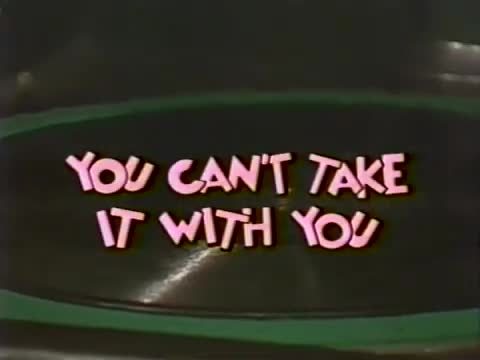
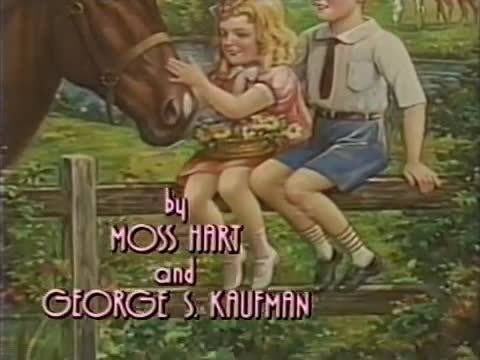



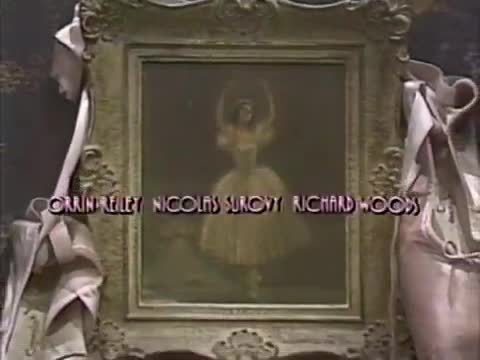

You Can't Take it With You - PBS - November 21, 1984
Musical (A presentation of "Great Performances")
Running Time: 116 minutes
Stars:
Jason Robards as Grandpa Martin Vanderhof
George Rose as Boris Kolenkhov
Elizabeth Wilson as Penny Sycamore
Colleen Dewhurst as Grand Duchess Olga Katrina
Maureen Anderman as Alice Sycamore
Carol Androsky as Essie Carmichael
Jack Dodson as Paul Sycamore
Alice Drummond as Gay Wellington
Christopher Foster as Ed Carmichael
Arthur French as Donald
Page Johnson as A man from the Department of Justice
Rosetta LeNoire as Rheba
Bill McCutcheon as Mr. De Pinna
Meg Mundy as Mrs. Anthony P. Kirby
Orrin Reiley as Henderson
Nicholas Surovy as Tony Kirby
Richard Woods as Anthony P. Kirby
Jason Robards III as Mac
Wayne Elbert as Jim
#You Can't Take it With You#TV#PBS#1984#Musical#Jason Robards#George Rose#Elizabeth Wilson#Colleen Dewhurst
4 notes
·
View notes
Text

Jean Joseph Étienne Lenoir (January 12, 1822 - August 4, 1900) in 1860 used an electric spark plug in his gas engine, the first internal combustion piston engine. He is generally credited with the invention of the spark plug. Some sources credit Edmond Berger, an immigrant from Togo, with creating a spark plug in early 1839, though records show he did not receive a patent for his device.
Early patents for spark plugs included those by Nikola Tesla (US Patent 609,250 for an ignition timing system, 1898), Frederick Richard Simms (GB 24859/1898, 1898), and Robert Bosch (GB 26907/1898). Only the invention of the first commercially viable high-voltage spark plug as part of a magneto-based ignition system by Robert Bosch’s engineer Gottlob Honold in 1902 made possible the development of the spark-ignition engine. Manufacturing improvements can be credited to Albert Champion to the Lodge brothers, sons of Sir Oliver Lodge, who developed and manufactured their father’s idea, and to Kenelm Lee Guinness, of the Guinness brewing family, who developed the KLG brand. Helen Blair Bartlett played a vital role in making the insulator in 1930. #africanhistory365 #africanexcellence
0 notes
Text

Fred Frith & Tim Hodgkinson Instants Chavirés, 7 rue Richard Lenoir, Montreuil ! Le 10.10.2024 © Isabelle Duthoit
0 notes
Text


Plaque en hommage à : Robert Desnos
Type : Lieu de résidence
Adresse : 19 rue Mazarine, 75006 Paris, France
Date de pose : Inconnue
Texte : Ici vécut de 1934 à 1944 Robert Desnos, poète français. Arrêté par la Gestapo et déporté, il trouva la mort parce qu'il était épris de liberté de progrès et de justice
Quelques précisions : Robert Desnos (1900-1945) est un poète et résistant français. Passionné par la poésie depuis l'enfance, il trouve dans les années 1920 sa place dans le surréalisme, publiant ainsi dans La Révolution surréaliste. Exclu par André Breton sur fond de désaccord politique, il n'en poursuit pas moins sa carrière de poète, influencé par de nombreux styles musicaux. Dans les années 1930, devenu rédacteur publicitaire et écrivain pour la radio (notamment de La Complainte de Fantômas), il s'inquiète de la montée du fascisme en Europe et adhère à des mouvements intellectuels antifascistes. Pendant la Seconde Guerre mondiale, il rejoint le réseau de Résistance AGIR, venant en aide aux Juifs et à d'autres résistants tout en faisant paraître des poèmes critiquant le régime de Vichy et le nazisme. Arrêté en 1944, il est déporté au camp de Buchenwald puis à Theresienstadt. Malgré la fuite des nazis et la libération du camp, il tombe malade du typhus et meurt un mois seulement après la fin de la guerre. Une autre plaque commémorative en son honneur peut être trouvée rue Richard Lenoir, dans le 11ème arrondissement de Paris, où il résida également.
Ne pas confondre avec Louis Desnos, un autre résistant français également mort pendant la Seconde Guerre mondiale et commémoré par une plaque commémorative à Paris.
#individuel#hommes#residence#ecrivains#poetes#seconde guerre mondiale#resistance#france#ile de france#paris#robert desnos#non datee
1 note
·
View note
Text

Bon jour, ☕️ 🥐 🍊bon Week-end à tous
La Grosse Bouteille,bd Richard Lenoir🗼Paris 1959
Photo de Robert Doisneau
#photooftheday#photography#black and white#vintage#robert doisneau#paris#brasserie#la grosse bouteille#bonjour#bon week-end#fidjie fidjie
59 notes
·
View notes
Text
Ober Mamma boulevard Richard-Lenoir Paris : l'adresse italienne qui enchante Paris
Sur le boulevard Richard-Lenoir, Ober Mamma s’impose comme une adresse incontournable pour les amateurs de cuisine italienne à Paris. Derrière ses grandes baies vitrées, une ambiance chaleureuse et conviviale accueille les gourmands venus des quatre coins de la capitale. Les effluves de pizza cuite au feu de bois et les arômes de pasta fraîchement préparée se mêlent pour titiller les…
0 notes
Text
O objetivo dessa seção do blog é dedicada a falar de restaurantes franceses com preços acessíveis e com comidas gostosas, para quem quer sair um pouco da rota turística, onde as alternativas de restaurante são caras e as vezes apenas armadilhas para turistas.
A primeira dica que dou é, antes da viagem, pesquisar na internet recomendações de restaurantes nas cidades onde for visitar. Vá anotando todos os nomes e depois pesquise diretamente pelo nome dos estabelecimentos, é provável que alguns blogs indiquem restaurantes caros ou que não servem o tipo de comida que você gosta, por isso vale a pena pesquisar em várias fontes diferentes (se possível, até em sites franceses).
Outra dica muito importante é se organizar para comer nos horários “normais”. Apesar de haver restaurantes em Paris que funcionem o dia todo, muitos locais têm horários de abertura e fechamento bem restritos (por exemplo, almoço das 12h às 15h e jantar das 19h às 22h).
Sege algumas recomendações de restaurantes para aqueles interessados nos meus achados:
Ravioli Chinois Nord Est

Um pequeno restaurante chinês em Bevenille, o restaurante é especializado em raviólis recheados de diversas maneiras, com carne de boi, de porco e até vegetarianos. São 11 opções, você pode escolher se vai ser frito ou cozido a vapor! Cerca de 10 raviólis por 5 euros, uma pechincha!
So Nat

Um restaurante vegano com tigelas de combinações variadas e coloridas, frutas, legumes, sementes, nozes, cereais e muito tempero marcam esse restaurante na cabeça de quem vai. O menu do dia vem com uma entrada, prato principal e sobremesa, tudo a 9 euros.
Banoi

Um restaurante vietnamita especializado em rolinhos primavera, no almoço de 3 rolinhos vem uma sopa de cogumelos como entrada, rolinhos primavera e sobremesa por 9,40 euros
Lingerie des Grands Voisins

um ótimo lugar para ter um almoço tipicamente Frances, servem ao meio dia durante a semana da refeição completa com produtos da estação, os pratos também de 10 euros, uma refeição deliciosa, rápida e barata.
La Bossue

Atenção, excede 10 euros, mas por 0,50 centavos não podia não estar na lista. No menu, uma entrada que geralmente é uma sopa quente ou fria (de acordo com o clima), de prato : um quiche ou um gratinado ou um risoto acompanhado de uma pequena salada, junto com o bom humor dos garçons e a experiência fica perfeita!
Supermercados e feiras
Uma ótima opção para comer bem e barato em Paris e na França é comprar comida em supermercados e feiras de rua e depois fazer um belo piquenique ao ar livre! Os preços do supermercado são obviamente muito menores do que os dos restaurantes e você poderá encher a sacola com chocolates, geleias, mostardas, frios, queijos, frutas, pães e até mesmo alguns tipos de comidas prontas.
Além disso, aquele vinho francês que aqui no Brasil você não pode nem olhar que já fica pobre, no supermercado da França dificilmente vai custar mais de 6€.
Em Paris, há diversas feiras espalhadas pela cidade, cada uma em um dia da semana. Deixo aqui alguns exemplos:
• Marché Saint Honoré – Place du Marché Saint Honoré 75001 Paris. Metro Pyramide. Nas quartas das 12h30 às 20h30 e nos sábados das 7h às 15h.
• Marché Bastille (o maior de Paris) – Boulevard Richard Lenoir entre rue Amelin e rue Saint Sabin 75011 Paris. Metro Bastille. Às quintas das 7h às 14h30 e aos domingos das 7h às 15h.
• Marché du Président Wilson – Avenue du Président Wilson entre rue Debrousse e Place Iéna 75016 Paris. Metro Iéna. Quartas e sábados das 7h às 15h.
• Marche des Enfants Rouge (coberto e o mais antigo da cidade) – terça à sábado, das 8h30 às 13h e das 16h às 19h30; domingo, das 8h30 às 14.



0 notes
Text

Infinite Pau Hana - July 3, 2024
fourth of july
Hour 1
Move on Up - Curtis Mayfield Inner City Blues (Make Me Wanna Holler) - The Chi-Lites Beautiful Consumer -Christopher Claxton He Was a Friend of Mine - The Byrds There But for Fortune - Joan Baez Albuquerque - Neil Young Biological Speculation - Funkadelic Hey There - Sons of the Kingdom Machine Gun (live) - Jimi Hendrix Jesus, Etc. - Wilco
Hour 2
Mardi Gras in New Orleans - Professor Longhair The Promised Land - Chuck Berry Oh Louisiana - Chuck Berry Eisenhower Blues - J.B. Lenoir Big Brother - Stevie Wonder Alabama - John Coltrane Speak With Me - The Relatives Me and Paul - Willie Nelson I Pity the Poor Immigrant - Bob Dylan Now That the Buffalo's Gone - Buffy Sainte-Marie Lost Highway - Hank Williams The Beginning of the End - Jimmy Griggs Hey Jude - Wilson Pickett
Hour 3
Original Faubus Fables (live) - Charles Mingus You're the Man - Marvin Gaye It's Hard to Be a Saint in the City - Bruce Springsteen America - Simon and Garfunkel Billy 1 - Bob Dylan The Fenway - Jonathan Richman and the Modern Lovers House Un-American Blues Activity Dream - Mimi and Richard Farina Jimmy Carter Says Yes - Gene Marshall Yes We Can - Lee Dorsey American Music - Violent Femmes The Littlest Birds - The Be Good Tanyas
KTUH - 90.1 FM Honolulu, 91.1 FM North Shore, ktuh.org
0 notes
Text
From January 29th to February 9th, 2024
29-01-2024
JOHN CARPENTER & ALAN HOWARTH “Halloween II Original Soundtrack”; BOYS OF THE LOUGH “In The Tradition”; CHIC “C'est Chic”; SPARKS “Interior Design”; ABNER JAY “The Backbone Of America Is A Mule & Cotton”; THE NATACHA ATLAS & MARC EAGLETON PROJECT “Foretold In The Language Of Dreams”; TIM BUCKLEY “Happy Sad”; CORNERSHOP FEATURING BUBBLEY KAUR “Cornershop And The Double “O” Groove Of...”; EDDIE VINSON “Cleanhead Blues”; GRUFF RHYS “Yr Atal Gedhedlaeth”; LEONARD COHEN “Dear Heather”; ELMORE JAMES “Dust My Broom”; GERSHON KINGSLEY “Music To Moog”; EUROS CHILDS “Gingerbread House Explosion”; GUIDED BY VOICES “Universal Truths & Cycles”
06-02-2024
GROOVE ARMADA “Vertigo”; CATATONIA “International Velvet”; EUROS CHILDS “Chops”; MILES KANE “Change The Show”; BLAKE BABIES “Nicely, Nicely”; EARL HOOKER & JUNIOR WELLS “Earl Hooker & Junior Wells”; ABBA “Ring Ring”; LOWELL FULSON “West Coast Blues”; KROKODIL “Swamp”; GRUFF RHYS Candylion”; PRIMAL SCREAM “Riot City Blues”; MILEY CYRUS “Bangerz”; SPARKS “Angst In My Pants”; THE POLICE “Ghost In The Machine”; LINDISFARNE “Dingly Dell”; PROFESSOR LONGHAIR “New Orleans Piano”
07-02-2024
BUKKA WHITE “Parchman Farm Blues”; AMON DUUL II “Yeti”; JENS LEKMAN “When I Said I Wanted To Be Your Dog”; MEMPHIS JUG BAND “Walk Right In”; SONIC YOUTH “Rather Ripped”; J.B. LENOIR “Eisenhower Blues”; SALTY DOG “Every Dog Has It's Day”; GUIDED BY VOICES “Let's Go Eat The Factory”; SQUAREPUSHER “Hello Everything”; BMX BANDITS “C86”; TAKE THAT “Beautiful World”
08-02-2024
LEON ROSSELSON “Wo Sind Die Elefanten?”; KRISTIN HERSH “Possible Dust Clouds”; NATACHA ATLAS “Gedida”; CATHY DAVEY “Tales Of Silversleeve”; EMMYLOU HARRIS “Luxury Liner”; ZERO 7 “Simple Things”; GOLDIE “Timeless”; ERIC BOGLE “Voices In The Wilderness”; EELS “Souljacker”; THE CARDIGANS “First Band On The Moon”; GUIDED BY VOICES “Vampire On Titus”
09-02-2024
SPARKS “Balls”; RICHARD THOMPSON “Live At Crawley, 1993”; STAN ROGERS “From Coffee House To Concert Hall”; THE SPIN DOCTORS “Homebelly Groove... Live”; STEELY DAN “Can't Buy A Thrill”
0 notes
